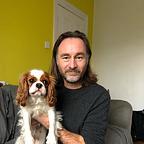Why is less more?
There’s a persistent assumption in the creative industry that reduction is always better.
Ad grads raised on the billboards of David Abbot, Tony Brignull, Paul Arden & co see simplicity as the be-all of creativity. M&C Saatchi has ‘brutal simplicity of thought’ as its mantra. Hegarty, Saatchi, Arden and many others have published nicely manbag-sized books which you can buy at Waterstones for around £9.99. They have sold in their thousands and contain about a hundred words each, so dedicated are they to the craft of reduction.
And don’t
get me started
on Dave Trott’s
columns.
LinkedIn and Pinterest and the Chip Shop Awards are full of fake minimal posters for familiar brands, none of which would ever see the light of day in the real world. Because they’re not very good — they’re just very simple.
But we no longer live in a managed, buyable, broadcast world, where a 96-sheet or a DPS in the Sunday supplements is the ideal canvas for creative excellence. We have the space to tell stories, to create universes, to hand over ideas, kick them around and let them evolve across platforms. Even a beautifully simple thought like Marmite’s ‘love it or hate it’ can come to life in packaging, in a DNA kit, in a mind control experiment. It has personality, angles, options, a life of its own. We could probably all make a Marmite idea if we tried. But another Marmite poster? Who needs one?
Where does it come from, this relentless drive towards reduction?
It might start in the world of the centrally-cast agency planner, who often arrives onto the scene wearing something monochrome, bias-cut, looking a bit like how they think an architect looks. Minimal. And there’s a reason for that too. The stated aim in planning has for years been to condense the creative problem into a shorter and shorter format:
“Write it on one side of A4!”
“Now do it on a post-it note!”
“Now do it in a sentence!”
“Now do it in a word!”.
The proposition. It’s their art form.
Paul Kitcatt has written elegantly of the ‘parti’ — the single stroke that an architect will make to form the basis of their drawing. In much the same vein, planners and creatives talk reverentially about the single-word propositions behind famous ads like Tango Orange and the Cadbury’s Gorilla. (Hit and Joy, respectively, I’m told).
I’m a bit annoyed that I’ve never seen a proposition reduced to a syllable yet, or maybe a sound, or just a symbol, like Prince. I’m sure it’s happened though.
Reduce, reduce, reduce.
And yet, much great work has been done that refuses to follow this reductionist formula. Mark Denton’s The Power of Puerility is a hymn to this kind of creative maximalism (and it has many more than 100 words in it too).
Honda’s Power of Dreams is another wonderful example of expansionist, collaborative thinking that aimed to create a messy and beautiful universe, not a perfect mantra.
The end result wasn’t a brief or a proposition, it was a book — The Book of Dreams — that enabled client and agency to agree a shared vision of strategy and execution, and which lead in turn to two years of highly effective, award-winning advertising. Fun, surprising, colourful, generous and very memorable advertising, at that.
It’s not in the same league, or even the same game, but the #Untapped campaign we created at GOOD with WaterAid came with a creative strategy document that enabled anyone to create content within the ‘universe’ of Untapped. So WaterAid’s internal team and GOOD’s creative team were able to make brilliant work completely separately, from cinema to TV to outdoor to chatbots to DM to YouTube tutorials and over 200 other pieces of digital content. Bar the odd exception, it all worked together, growing and reinforcing the Untapped universe to drive more and more reach, engagement and results. And all without the complex, hierarchical approval process you’d find in most organisations. Indeed, I first saw the cinema ad, made by WaterAid’s brilliant team, in the actual cinema. It blew me away and yet I recognised it as ‘our’ work completely.
Untapped was a universe where many things could happen, but guided by broad organising principles that made it all work.
And yet, a proposition would have seemed so beautifully simple. We would have printed it out, stuck it on the wall and nodded in unison. We would have marvelled at its simplicity. And then we would all have gone off and made wildly different and contradictory work that we interpreted as being perfectly ‘on brief’. (That’s one reason why people like propositions, they often allow them to do whatever they were going to do in the first place.)
Yet still the worship of reduction persists, in books and speeches and brand books and blog posts and, most depressingly of all, in student portfolios too.
Meanwhile, in the real world, more is more. We don’t watch movies, we binge box sets with series after series, spin off after spin off. We don’t read books, we consume trilogies. We don’t buy singles, we stream playlists or 12-hour DJ sets. We don’t play games, we spend hours in epic, ever-expanding universes.
But not in advertising.
We want to get rid of words and pictures.
But people like words and pictures.
We want to make billboards.
But no-one looks at billboards.
We want to shorten propositions.
But we need to create universes.
We behave as we’re still in a world of scarcity.
When we’re in a world of abundance.
What if less is less?
And more is more?
